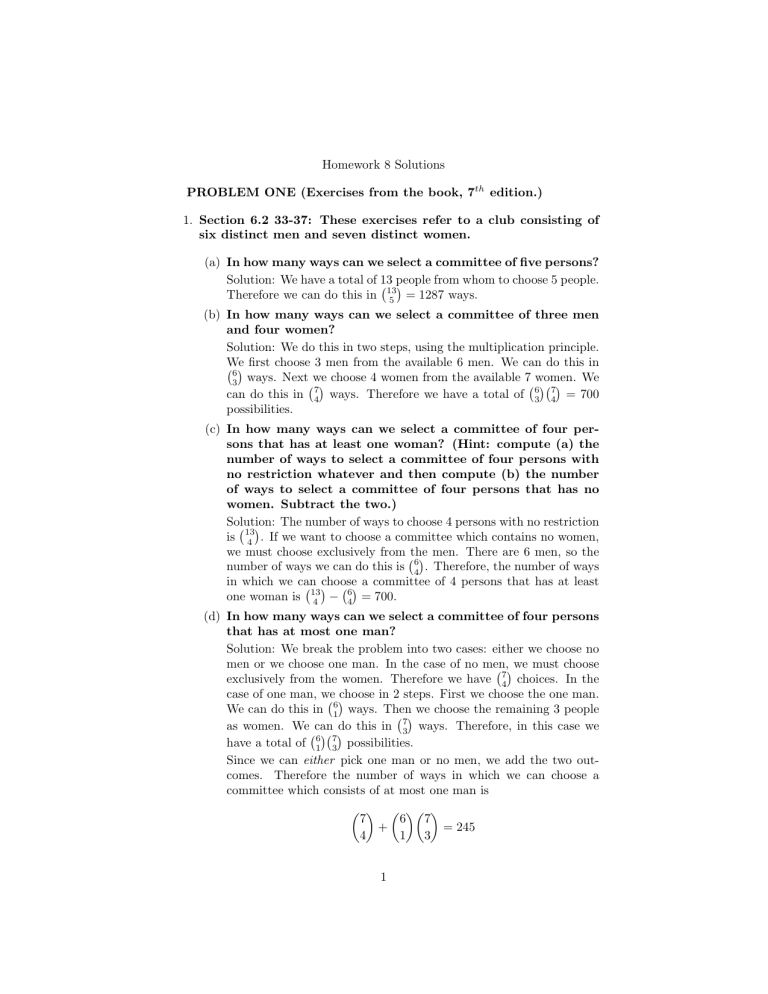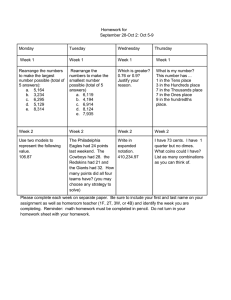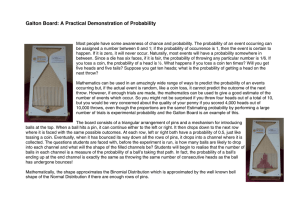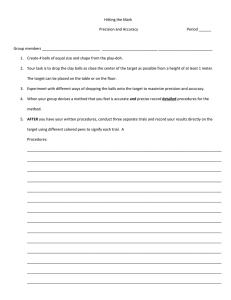Homework 8 Solutions PROBLEM ONE (Exercises from the book

Homework 8 Solutions
PROBLEM ONE (Exercises from the book, 7 th edition.)
1.
Section 6.2 33-37: These exercises refer to a club consisting of six distinct men and seven distinct women.
(a) In how many ways can we select a committee of five persons?
Solution: We have a total of 13 people from whom to choose 5 people.
Therefore we can do this in
13
5
= 1287 ways.
(b) In how many ways can we select a committee of three men and four women?
Solution: We do this in two steps, using the multiplication principle.
We first choose 3 men from the available 6 men. We can do this in
6
3 ways. Next we choose 4 women from the available 7 women. We can do this in
7
4 ways. Therefore we have a total of
6
3
7
4
= 700 possibilities.
(c) In how many ways can we select a committee of four persons that has at least one woman? (Hint: compute (a) the number of ways to select a committee of four persons with no restriction whatever and then compute (b) the number of ways to select a committee of four persons that has no women. Subtract the two.)
Solution: The number of ways to choose 4 persons with no restriction is
13
. If we want to choose a committee which contains no women,
4 we must choose exclusively from the men. There are 6 men, so the number of ways we can do this is
6
4
. Therefore, the number of ways in which we can choose a committee of 4 persons that has at least one woman is
13
4
−
6
4
= 700.
(d) In how many ways can we select a committee of four persons that has at most one man?
Solution: We break the problem into two cases: either we choose no men or we choose one man. In the case of no men, we must choose exclusively from the women. Therefore we have
7
4 choices. In the case of one man, we choose in 2 steps. First we choose the one man.
We can do this in
6
1 ways. Then we choose the remaining 3 people as women. We can do this in
7
3 ways. Therefore, in this case we have a total of
6
1
7
3 possibilities.
Since we can either pick one man or no men, we add the two outcomes.
Therefore the number of ways in which we can choose a committee which consists of at most one man is
7
4
+
6
1
7
3
= 245
1
(e) In how many ways can we select a committee of four persons that has persons of both sexes?
Solution: Here we will use a method similar to the one we used in part (c), except I will explain it a bit more. Out of all possible choices of 4 persons (with no restriction whatever) we will call a particular choice good if it contains persons of both sexes and bad if it does not.
For example, the choice of 1 female and 3 males is good, whereas the choice of 4 females is bad. We are interested in the number of good choices and to find this we can calculate
(number of possible choices) − (number of bad choices)
The first number is just
13
4 since we can choose 4 persons from all 13 persons. We must now count the number of bad choices. If a choice is bad, then it consists of all men or all women. The number of all-men choices is
6
4
. The number of all-women choices is
7
4
. Therefore the number of bad choices is
6
4
+
7
4
. This gives the number of good choices to be
13
4
−
6
4
−
7
4
= 665
2.
Section 6.2 60-64: A coin is flipped 10 times.
(a) How many outcomes are possible? (An outcome is a list of
10Hs and Ts that gives the result of each of 10 tosses. For example, the outcome
H H T H T H H H T H represents 10 tosses, where a head was obtained on the first two tosses, a tail was obtained on the third toss, a head was obtained on the fourth toss, etc.)
Solution: We can perform this process in 10 steps, in which each step we choose H or T. There are 2 choices here, so we get 2 10 = 1024 possibilities.
(b) How many outcomes have exactly three heads?
Solution: We can calculate this by calculating the number of ways we can place 3 Hs among 10 blanks:
(1)
(note that once we place the Hs, the other spots are determined to be Ts). This can be done in
10
3
= 120 ways.
2
(c) How many outcomes have at most three heads?
Solution: If we choose at most three heads, we can have either 0 heads, 1 head, 2 heads, or 3 heads. This can be done in
10
0
+
10
1
+
10
2
+
10
3
= 176 ways.
(d) How many outcomes have a head on the fifth toss?
Solution: If the fifth toss is determined to be heads, the others can be either H or T. Therefore, we can choose the possibilities in 9 steps.
The number of possibilities is 2 9 = 512.
(e) How many outcomes have as many heads as tails?
Solution: Any such outcome must have 5 Hs and 5 Ts. We can choose these by placing 5 Hs among 10 blanks, as in (1), above. Therefore, there are
10
5
= 252 possibilities.
PROBLEM TWO
1.
Explain why the number of ways to put n identical red balls into r numbered bins is n + r − 1 r − 1
Solution: We use the method outlined before this question. To place balls into r numbered bins, we need to use r − 1 dividers. Each configuration of balls corresponds to an ordering of r − 1 dividers and n balls. Therefore to choose an ordering of these dividers and balls, it suffices to choose the places for the dividers (then the places for the balls will be determined).
There are a total of n + r − 1 places, so we have n + r − 1 r − 1 possibilities.
2.
A quiz has 5 problems and the grades are out of 10. In how many ways can points be allocated to the problems? For instance, we may assign 0 pts to problem 1, 4 points to problem 2, 1 point to each of problems 3 and 4, and then 4 points to problem 5.
Solution: This problem can be phrased as a problem with identical balls and numbered bins. Each point available (of 10 points) we view as an identical ball and each problem we view as a numbered bin. Therefore, the problem reads as follows: in how many ways can we place 10 identical balls into 5 numbered bins. From the previous problem, this corresponds to n = 10, r = 5. This gives
14
4
= 1001 possibilities.
3.
In how many ways can point be allocated to a quiz which has 4 problems so that the total score is 7? What if we insist that the first question be worth 2 points? What if we insist that the first question be worth at least 4 points?
3
Solution: The first question is essentially the same as the previous one: the answer is
10
3
= 120. If the first question must be worth 2 points, then we must allocate the remaining 5 points among the last 3 problems.
This can be phrased as the previous problem, with n = 5 and r = 3. This gives
7
2
= 21 possibilities.
If the first question is to be worth at least 4 points, then we break into 4 possibilities: either the first question is worth 4 points, 5 points, 6 points, or 7 points. In these cases, we need to distribute the remaining points among the last three questions. This gives
5
2
+
4
2
+
3
2
+
2
2
= 20 ways.
PROBLEM THREE
1.
Write all the ways we can rearrange the letters in the word
HOTS.
Solution: There should be 4! = 24 ways: HOTS, HOST, HSTO, HSOT,
HTSO, HTOS, OTSH, OTHS, OSHT, OSTH, OHST, OHTS, THOS,
THSO, TOHS, TOSH, TSOH, TSHO, SHOT, SHTO, STOH, STHO,
SOHT, SOTH.
2.
Split these rearrangements into equivalence classes such that two rearrangements are equivalent if we can switch the T and S in one rearrangement to get the other. For instance, the rearrangements HOTS and HOST are equivalent.
Solution: { HOT S, HOST } , { HST O, HT SO } , { HSOT, HT OS } ,
{ OT SH, OST H } , { OT HS, OSHT } , { OHST, OHT S } , { T HOS, SHOT } ,
{ T HSO, SHT O } , { T OHS, SOHT } , { T OSH, SOT H } , { T SOH, ST OH } ,
{ T SHO, ST HO }
3.
Write all the ways we can rearrange the letters in the word
HOSS. (Note here that the two S characters are identical.)
Solution: HOSS, HSOS, HSSO, OSSH, OSHS, OHSS, SOHS, SHOS, SSOH,
SHSO, SSHO, SOSH
4.
How are your answers for 2 and 3 related?
Solution: There are the same number of ways to rearrange the letters in HOSS as there are equivalence classes in part 2. This type of logic implies that if we want to find the number of ways to rearrange letters in a word which has only one letter which appears more than once, (e.g.
MAMMOM) we first arrange the letters assuming they are all different and then divide by the number of ways to rearrange the letter which appears more than once:
4
number of ways to rearrange all letters number of ways to rearrange the duplicated letter
5.
In how many ways can we rearrange the letters in the word
TATTER?
Solution: If we first distinguish the letters, that is, change the word to
TASHER, there are then 6! = 720 ways to order the letters. To account for the 3 identical letters, we divide by 3! = 6. Therefore, there are
720
6
= 120 ways.
5



